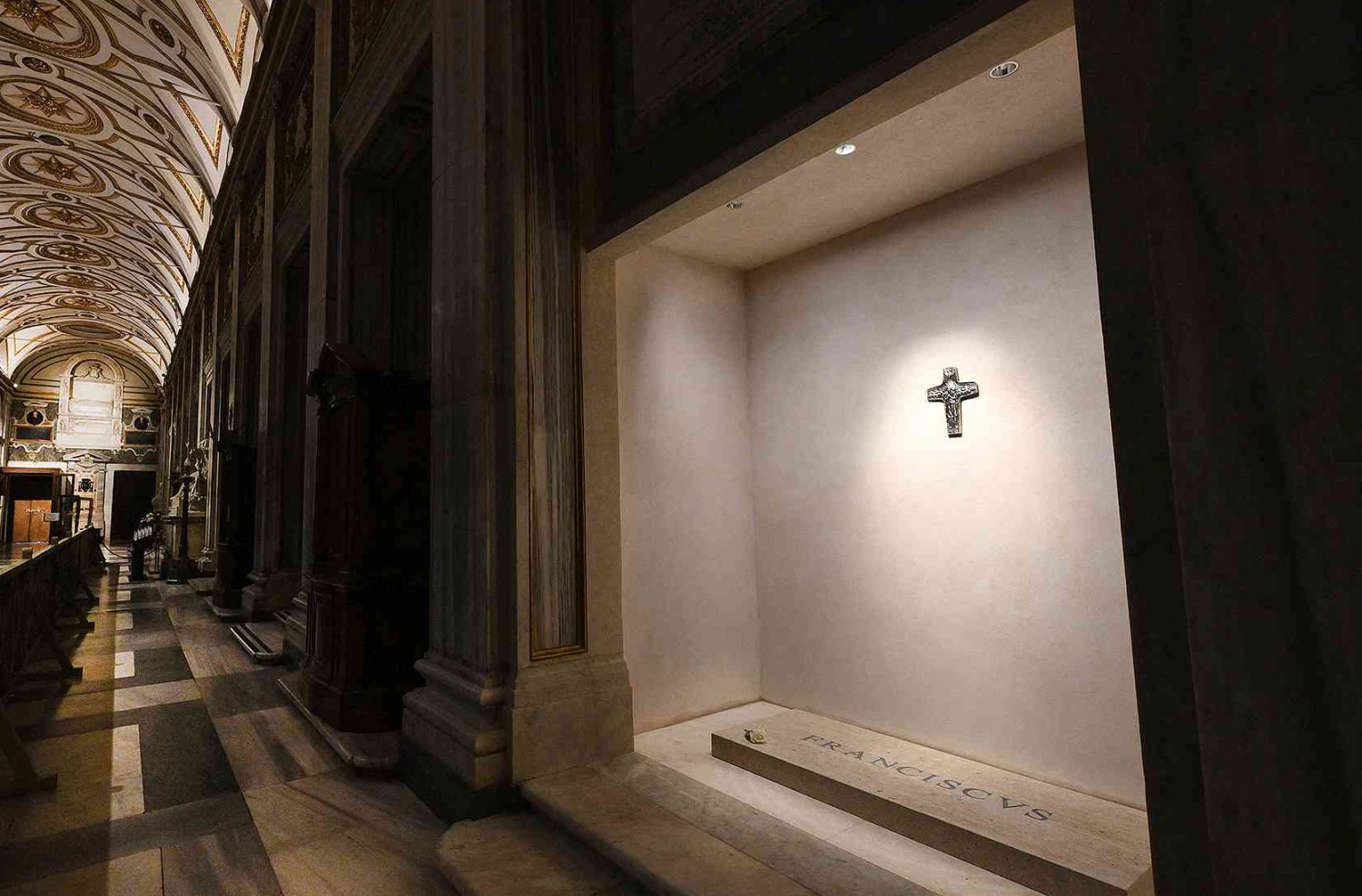The passing of Pope Francis has left the world in mourning, with millions of Catholics and followers across the globe reflecting on his legacy. Pope Francis, who served as the leader of the Roman Catholic Church for over a decade, passed away peacefully on Monday, April 24, 2025, at the age of 88, at the Saint Martha House in Vatican City. His death marked the end of a transformative era in the Catholic Church, and his final resting place has since become a point of reflection, attracting thousands of faithful visitors. But what is the significance behind Pope Francis’ humble tombstone, and why did he choose such simplicity for his final resting place? Let’s explore the meaning and symbolism behind the late pontiff’s burial and the message it sends.
A Simple Headstone: A Reflection of Pope Francis’ Life
When Pope Francis’ family and the Vatican made the decision to lay him to rest, the simplicity of his tombstone came as no surprise to those who had followed his tenure as the leader of the Catholic Church. Known for his advocacy for the poor, the marginalized, and his unwavering dedication to humility, Pope Francis lived his life in a way that reflected his belief in serving others rather than seeking grandeur or glory. His tombstone, a simple white marker inscribed with the word “Franciscus” — his name in Latin — mirrors this deep-rooted humility that characterized his papacy.
The tombstone is unadorned, reflecting the Pope’s desire for simplicity and his connection to the fundamental Christian values of humility and modesty. For Pope Francis, the act of being buried in such a simple manner represents the culmination of a life that did not seek materialism or the trappings of power. Rather, his life and ministry emphasized the importance of service, compassion, and devotion to God. His decision to forgo the ornate and elaborate tombs typical of many of his predecessors is a final testament to his teachings of humility.
:max_bytes(150000):strip_icc():focal(948x660:950x662):format(webp)/Tomb-Pope-Francis-Santa-Maria-Maggiore-Basilica-Rome-042725-02-ac87dfbdafbc4ec1ae7b1f25292c391e.jpg)
The tomb of late Pope Francis in Santa Maria Maggiore church in Rome.
Vatican Media/Abaca/Sipa USA
The Location of Pope Francis’ Resting Place
Pope Francis made the conscious decision to be buried in the Basilica of St. Mary Major, located just six kilometers from St. Peter’s Square. This choice was particularly notable because, traditionally, popes are buried in St. Peter’s Basilica in Vatican City. However, Pope Francis’ wishes were clear, and he opted for St. Mary Major as his final resting place, a location steeped in history and devotion to the Virgin Mary.
The Basilica of St. Mary Major is one of the four major basilicas of Rome and holds a deep significance within the Catholic tradition. It is known for its dedication to the Virgin Mary, and it has long been a symbol of the Church’s reverence for the Mother of God. Pope Francis’ request to be buried here is seen as an intentional reflection of his devotion to the Virgin Mary, a figure he often referred to as a source of maternal protection and love.
The fact that Pope Francis chose to rest in this basilica, instead of following tradition by being interred in St. Peter’s Basilica, carries profound spiritual significance. According to reports, Archbishop Rolandas Makrickas had suggested this location back in 2022, and Pope Francis had expressed his desire for his tomb to be simple, allowing the focus to remain on honoring the Madonna. Pope Francis did not wish for the burial site to be the focal point; rather, he wanted to venerate Mary in a manner that reflected the values he upheld during his life.
The Symbolism Behind the Simple Tombstone
Pope Francis’ tombstone, while simple in its design, speaks volumes about the Pope’s life and the message he wished to leave behind. The minimalistic nature of the tombstone signifies a life dedicated to service, rather than one consumed by status or wealth. It stands as a reminder to Catholics and the world alike that true greatness is found not in wealth or grandeur but in humility, kindness, and devotion to others.
A single white rose placed at the foot of the tomb offers a symbolic gesture of remembrance and respect. The rose, which has long been associated with the Virgin Mary, is a subtle yet powerful symbol of purity and devotion. The light that illuminates the tomb, casting a warm glow over it, highlights the reverence with which Pope Francis’ memory is being honored. The reproduction of Pope Francis’ pectoral cross on the wall above the tomb adds a personal touch, linking his burial site to his papacy and his role as a shepherd to the faithful.
For many, the simplicity of the tombstone serves as a poignant reflection of Pope Francis’ character. Throughout his papacy, he lived a life that emphasized the importance of simplicity and empathy for those less fortunate. Whether it was his decision to live in the modest Vatican guesthouse instead of the grand papal apartments, or his efforts to reform the Vatican’s financial systems to promote transparency, Pope Francis consistently practiced what he preached: a life of humility in service of others.
:max_bytes(150000):strip_icc():focal(986x750:988x752):format(webp)/Tomb-Pope-Francis-Santa-Maria-Maggiore-Basilica-Rome-042725-05-c567f56891314d10a087cf6c27a4766b.jpg)
Pope Francis’ tomb at Santa Maria Maggiore church. Photo:
Eric Vandeville/Abaca/Sipa USA
The Funeral and Burial Ceremony
Pope Francis’ funeral was a solemn and emotional occasion, attended by a host of world leaders, religious figures, and countless faithful. The funeral mass, held in St. Peter’s Square, was a public event that drew an estimated 250,000 people. However, following the public ceremony, the Pope’s burial was carried out in private, in accordance with his wishes. His family, close friends, and key Vatican officials were present during the more intimate ceremony, and the proceedings were kept respectful and dignified.
The private nature of the burial ceremony reflects Pope Francis’ preference for simplicity and reverence. Despite his position as the leader of the Roman Catholic Church and the global attention his death generated, he wanted his final resting place to be marked by humility, not spectacle. In a way, this choice embodies the very essence of his ministry and his belief that serving others and focusing on the spiritual life is far more important than external honors.
The Global Outpouring of Grief and Tribute
Since the announcement of Pope Francis’ death, tributes have poured in from across the globe. World leaders, religious figures, and ordinary citizens alike have expressed their sorrow at the loss of a leader who dedicated his life to the service of others. Many have shared stories of how Pope Francis’ actions and words inspired them to live with greater compassion, humility, and care for the poor and marginalized.
The emotional tributes reflect the far-reaching impact Pope Francis had during his papacy. His call for social justice, his commitment to interfaith dialogue, and his steadfast advocacy for the environment made him a beloved figure not just within the Catholic Church, but also on the global stage. His simple and profound approach to leadership left an indelible mark on the hearts of millions, and his death has left a void that will be deeply felt for years to come.
A Final Message of Humility
In his final resting place, Pope Francis leaves behind a legacy of humility, compassion, and love. His choice to have a simple tombstone, free from grandeur, serves as a powerful reminder of the values he held dear throughout his life and papacy. As the world continues to mourn his passing, his example remains an enduring source of inspiration for people of all faiths.
Pope Francis’ life, and now his tomb, continue to symbolize the beauty of simplicity, the importance of service, and the deep connection he had with those who were often overlooked. In a world filled with distractions and materialism, his final resting place at St. Mary Major Basilica stands as a testament to the enduring power of faith, humility, and love for others.
As the faithful visit his tomb, they are not only honoring his memory but are reminded of the profound impact one life, lived with humility and devotion, can have on the world. Pope Francis may be gone, but his message of love, compassion, and service will continue to inspire generations to come.

